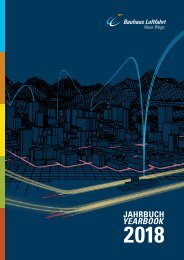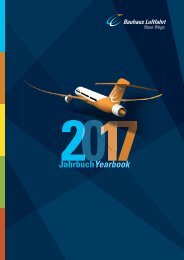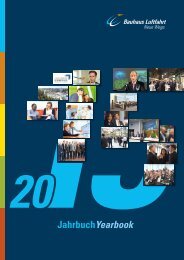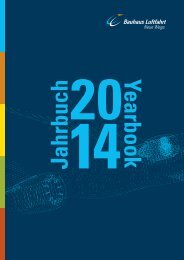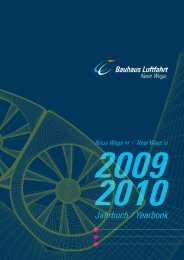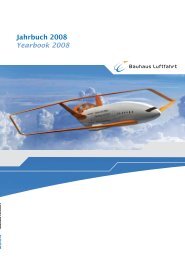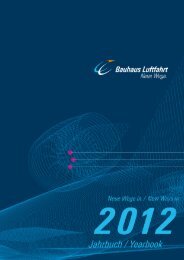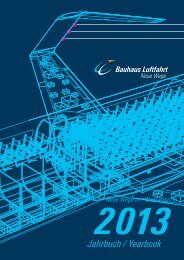Bauhaus Luftfahrt Jahrbuch 2019
- No tags were found...
Create successful ePaper yourself
Turn your PDF publications into a flip-book with our unique Google optimized e-Paper software.
55
Darstellung des CENTRELINE-
Propulsive-Fuselage-Flugzeugkonzeptes
Die computererzeugte Konzeptdarstellung zeigt das CENTRELINE-
Propulsive-Fuselage-Flugzeug mit den beiden klassisch am Flügel
installierten Triebwerken und dem zusätzlichen BLI-Antrieb am Heck
des Rumpfes.
Rendering of the CENTRELINE Propulsive
Fuselage aircraft concept
The computer-animated concept rendering shows the CENTRELINE
Propulsive Fuselage aircraft with its classic underwing-podded main
engines and the additional BLI propulsive device installed at the
aft-fuselage.
Untersuchung optimaler
Kraftstoffeinsparpotenziale
für PFC-Flugzeuge
Die Abbildung zeigt die Kraftstoffeinsparpotenziale
und die zugehörigen optimalen
Designparameter für PFC-Flugzeuge.
Die Einflüsse von Wirkungsgrad und
Leistungsgewicht des Antriebsstranges
zum Rumpf-Fan sind parametrisch erfasst.
Study of optimum fuel
burn reduction potentials
for PFC aircraft
The figure shows the PFC fuel saving
potentials and corresponding optimum
PFC aircraft design parameters. The
results are presented parametrically
against the efficiency and specific power
of the fuselage fan power train.
Optimum PFC fuel burn reduction [%]
11
10
9
8
7
6
5
4
3
2
1
0
20 %
end = 1
1.01
1.02
1.03
FF power train specific power (P/W PT,FF )
FF rel. power (P disc,FF /P co,eff,tot )
A/C gross weight at end of ∆R ( end)
Power saving coefficient (PSC)
15 %
25 %
PSC = 4 %
1.04
Turbo-electric
transmission scenario
30 %
5 %
P disc,FF /P co,eff,tot = 40 %
35 %
6 %
Mechanical
transmission scenario
86 88 90 92 94 96 98 100
Efficiency of fuselage fan power train (η PT,FF ) [%]
7 %
1.05
8 %
8 %
P/W PT,FF = 50 kW/kg
10 kW/kg
5.0 kW/kg
3.0 kW/kg
2.0 kW/kg
1.5 kW/kg
1.0 kW/kg
0.8 kW/kg
Study settings:
Long-range air
transport task
(6500 nmi, 340 Pax)
EIS 2035 technology
Dr. Arne Seitz Co-lead Energy Technologies and Power Systems
Rumpfgrenzschichteinsaugung bleibt einer der vielversprechendsten Ansätze für hochgradig integrierte Flugantriebe.
Die inhärenten Vorteile sind vollständig kompatibel mit hocheffizienter Flügelaerodynamik, etwa durch natürliche
bzw. hybride Strömungslaminarität oder selbsttrimmende Flügeleigenschaften, wie auch mit radikalen Triebwerkskreisprozessen.
Besondere Synergien könnten sich beim Einsatz von Flüssigwasserstoff als Flugkraftstoff ergeben. Das Propulsive-Fuselage-
Konzept sollte als ein mögliches Schlüsselelement in ganzheitlichen Technologiepaketen für zukünftige ultraeffiziente Flugzeuge
betrachtet werden – insbesondere für die Langstrecke.
Fuselage wake-filling propulsion integration remains one of the most promising fields for highly efficient, tightly coupled
propulsion-airframe design. Its benefits are fully compatible with ultra-efficient wing aerodynamics including hybrid or
natural flow laminarity and self-trimming wing properties as well as radically advanced aero engine cycle technologies. Particular
synergies may arise when combined with liquid hydrogen fuel. Propulsive Fuselage technology should be regarded as a possible key
item within an overall technology package for ultra-efficient aircraft design – especially for the long-range market segment.



